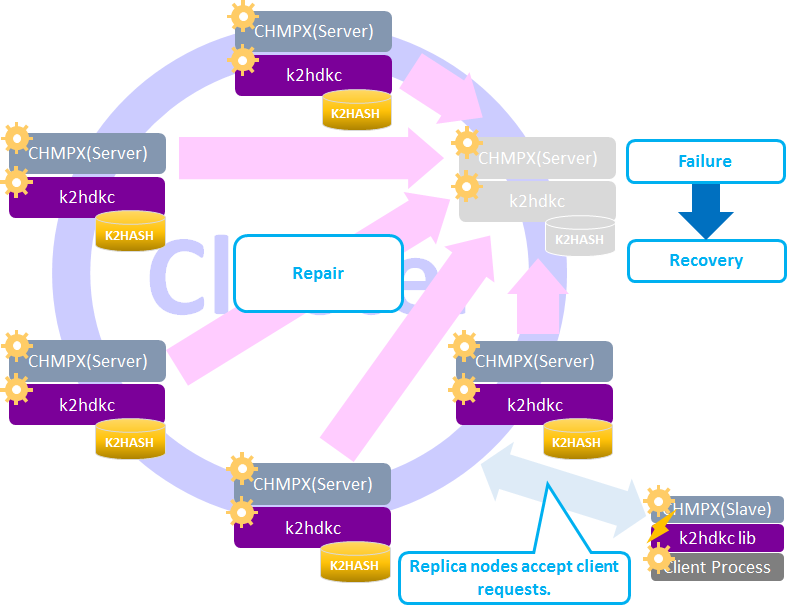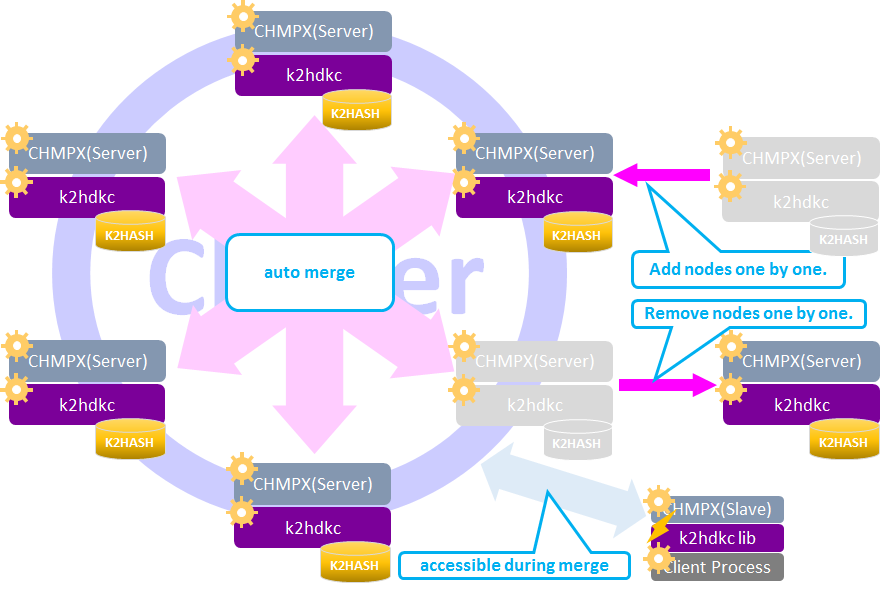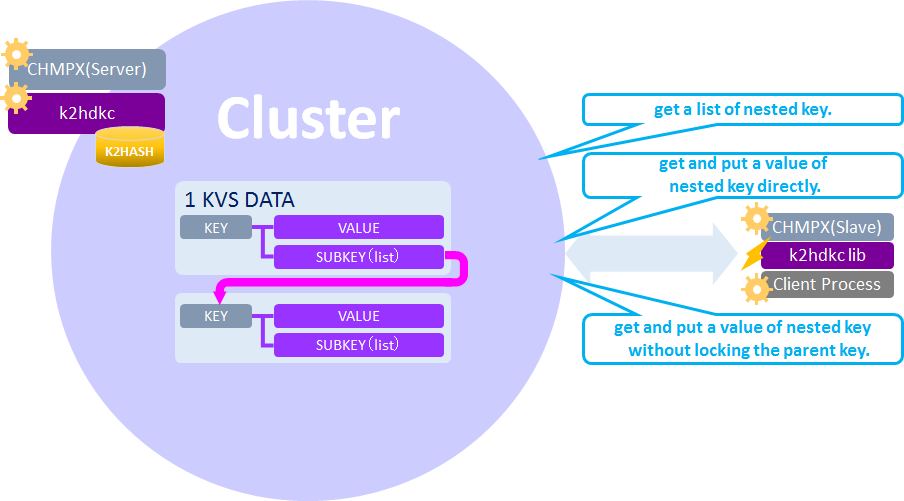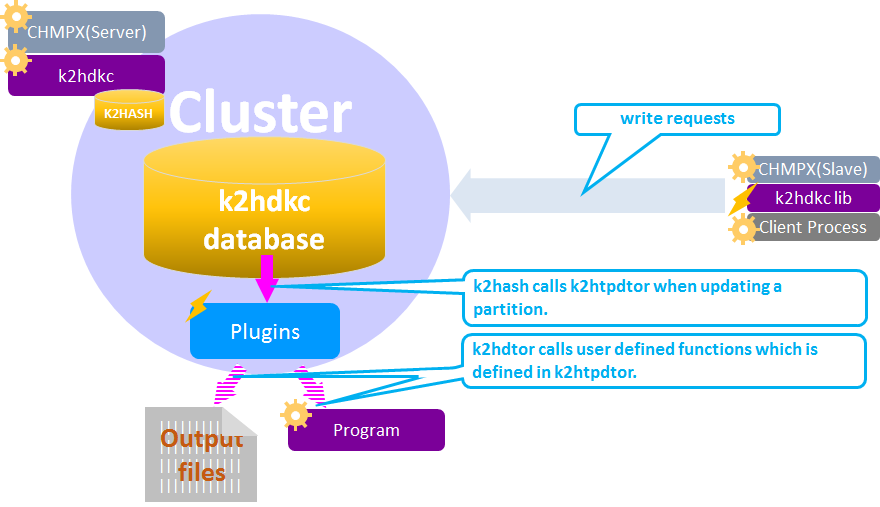Feature
K2HDKC is a highly available and scalable distributed KVS clustering system and also feature many useful and unique functions.
Flexible installation
We provide suitable K2HDKC installation for your OS. If you use Ubuntu, CentOS, Fedora or Debian, you can easily install it from packagecloud.io. Even if you use none of them, you can use it by Build by yourself.
Automated data synchronization between server nodes.
- Automatic Merging
After recovering from transient node failures, data will be relocated automatically. - Automatic Scaling
When adding/removing nodes, data will be relocated automatically.
Nested key structure
this functionality is derived from the Sub key function of K2HASH.
Queue
CAS(Compare And Swap)
Data Encryption
Data Expiration
Transaction Plugins
Changing data invokes user defined functions in the K2HTPDTOR plugin.
Automatic Merge
Automatic Merge is a processing mechanism that restores data consistency of a server node returning from the down state or suspended state to the normal state.
Note: The suspended state means the K2HDKC process is dead.

After recovering from transient node failures, K2HDKC automatically restores data of the failure node.
Let’s see the flow to restore data.
| phase | status | description |
|---|---|---|
| #1 | Server node failure occurred. | The CHMPX process or the K2HDKC process in a server node is dead. The server node is unavailable in this situation. |
| #2 | Server node is still failing. | While a failure occurs, the replica node handles the request on behalf of the failed server node. That’s why clients can keep sending requests and getting responses without a server node. |
| #3 | Server node failure removed. | The cause of the failure will disappear when the CHMPX and K2HDKC process successfully restart. Then the node becomes the [Pending] CHMPX state. The K2HDKC process starts gathering only data that it does not have from the replica node. The failed node will not accept requests from clients during this situation. |
| #4 | Data merge completed. | After gathering data from the replica node, the server node becomes the [UP and No Suspend] CHMPX state. The server node starts accepting requests from clients again. |
Automatic Scaling
Automatic Scaling is a processing mechanism to relocate the data held by each server node when increasing or decreasing server nodes in the cluster. The Automatic Scaling is basically the same logic with the Automatic Merge.

K2HDKC determines the locations of keys in the cluster by calculator of keys and the number of nodes in the cluster. K2HDKC has no mapping of range and node though K2HDKC’s partitioning scheme relies on consistent hashing like Riak or Cassandra. When a new node is added to the cluster, K2HDKC detects the keys to be relocated and copies them to their locations.
Let’s see the flow to move data when increasing nodes in the cluster.
| phase | action | status | description |
|---|---|---|---|
| #1 | Adding a node. | Adding | The node becomes the [Pending] CHMPX state and the K2HDKC state is [Doing]. |
| #2 | Starting merging data. | Every node in the cluster voluntarily starts collecting its own data. New node doesn’t accept requests from clients. Server nodes corresponding to the data arrangement before starting data merge still accept requests from clients in this phase. |
|
| #3 | Completed merging data. | All nodes have finished collecting its own data. New node starts accepting client requests. |
Let’s see how data moves when decreasing nodes in the cluster.
| phase | action | status | description |
|---|---|---|---|
| #1 | Deleting a node | Deleting | The node to be deleted from the cluster becomes the [Pending] CHMPX state and K2HDKC state is [Doing]. In this phase, the node only sends a decommission requests from the cluster and still receives requests from clients. |
| #2 | Starting merging data. | Every node except for the node to be deleted voluntarily start collecting its own data. The node to be deleted only sends a decommission requests from the cluster and still receives requests from clients. In other words, Server nodes corresponding to the data arrangement before starting data merge still accept requests from clients in this phase. |
|
| #3 | Completed merging data. | The node is completely decommissioned. All nodes finished collecting its own data. When having completed merging data, all nodes automatically start accepting client requests based on the new data arrangement. |
If the target node is already in the down state (or suspended state) at the time of node deletion, the replica node will keep the data that the target node takes charge. It means the replica node can handle client requests in the merging data phase.
Nested key structure
K2HDKC supports nested key data structure which means K2HDKC can store a key-value pair and a nested key-value pair. This functionality is derived from the Sub key function of K2HASH.

Queue
K2HDKC supports a FIFO(first-in-first-out) and LIFO(last-in-first-out) queue data structure which is also a K2HASH’s function. This means that K2HDKC can store a value and a key-value pair in a queue data structure.
CAS(Compare And Swap)
K2HDKC supports CAS(compare-and-swap) operations by using K2HASH and other mutex functionality. K2HDKC updates a value of a key after reading the current value of the key to check if it matches the expected one. Typical use cases of CAS operations are increment or decrement a counter, updating a mutex data item and so on.
Data Encryption
K2HDKC supports data encryption which is also a K2HASH’s function. This is the reason why K2HDKC can securely store and manage sensitive data.
Data Expiration
K2HDKC supports data expiration. K2HDKC deletes data with exhausted time-to-live. A typical use case of this function is some kind of a cache system. The K2HDKC’s data expiration functionality comes from K2HASH.
Transaction Plugins
K2HDKC can invoke user defined functions which is defined in K2HASH’s k2htpdtor or custom transaction plugins after data has changed(k2htpmdtor) when changing data.
